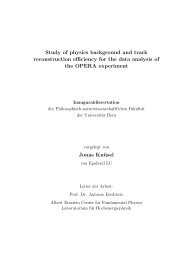Experiment Proposal - opera - Infn
Experiment Proposal - opera - Infn
Experiment Proposal - opera - Infn
You also want an ePaper? Increase the reach of your titles
YUMPU automatically turns print PDFs into web optimized ePapers that Google loves.
5 Analysis of the electronic detectors data and brick finding<br />
5.1 Event generators and cross sections<br />
Neutrino-nucleon interactions are generated through the JETTA and RESQUE packages [69] developed<br />
in the framework of the CHORUS Collaboration. JETTA is based on the LEPTO model for deepinelastic<br />
neutrino interactions. The Fermi motion of the nucleons is treated by using a simple Fermi gas<br />
model in which nucleons are considered as free fermions in a finite volume. The reinteractions of hadrons<br />
while crossing the nucleus are not taken into account. Hadronic fragmentation at the primary vertex is<br />
accomplished according to the LUND string model, with some tuning in order to reproduce experimental<br />
neutrino data. For DIS ν τ interactions the mass of the τ in the final state and its polarization are taken<br />
into account.<br />
The RESQUE package simulates quasi-elastic interactions and resonance production in neutrino<br />
scattering. Nuclear effects such as Fermi motion and Pauli suppression are taken into account, but not<br />
nuclear reinteractions. The simulation of quasi-elastic events is based on the calculation performed by<br />
Llewellyn-Smith [70]. The resonance production cross section is computed by using a simplified version<br />
of the Rein and Seghal model [71], which simulates various states up to a W value of 2 GeV without<br />
taking into account the interference terms. The effects of the mass of the τ on the kinematic of the final<br />
state and its polarization are also taken into account. A more complete simulation of the resonances<br />
based on [71] is being developed also including the effects of the τ mass at the level of dynamics.<br />
5.2 Detector simulation<br />
A GEANT 3.21 simulation has been performed (AIDA) which takes into account the detector geometry<br />
and the materials. All the primary tracks from the neutrino interaction in the target are generated<br />
according to the event generators and traced through the entire apparatus taking into account all relevant<br />
physics processes. Secondaries down to 1 MeV kinetic energy for electrons and γ’s, and down to 10 MeV<br />
for all other particles are also traced. Information about each particle crossing the active detectors is<br />
recorded, to provide data input for the event reconstruction programs. This information, classified as<br />
hits, includes detector identifier, crossing position, energy deposition, particle kinematics, etc.<br />
Signals produced in the scintillator strips are simulated assuming readout at both ends through 1 m<br />
of extra fibre and taking into account the light attenuation along the fibres. In order to validate the<br />
simulation of the electronic detectors, AIDA has been used to simulate the setup used in the test beam<br />
measurements. In one of these tests, 15 GeV/c pions were sent into a brick wall and the shower centre<br />
of gravity was measured by means of scintillator strip planes. The comparison of the differences between<br />
the true position of the beam in one transverse coordinate and the reconstructed one is shown in Fig. 73.<br />
The agreement gives us confidence in the simulation algorithms.<br />
In addition, a detailed simulation of the bricks has been performed to study the event topology in the<br />
vertex region, to estimate the physics background and to study different brick configurations. A standard<br />
GEANT 3.21 software requiring high performance in terms of tracking step length, position resolution<br />
and machine precision was used for this purpose.<br />
101




